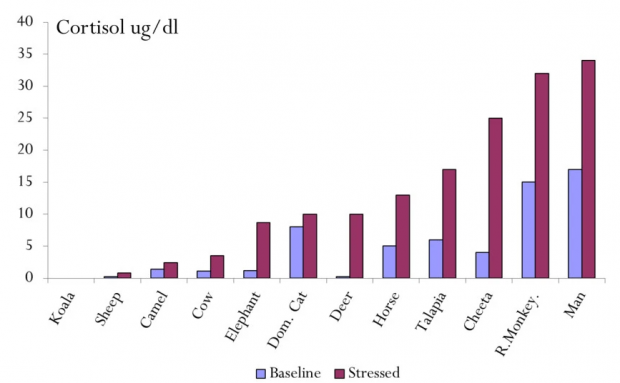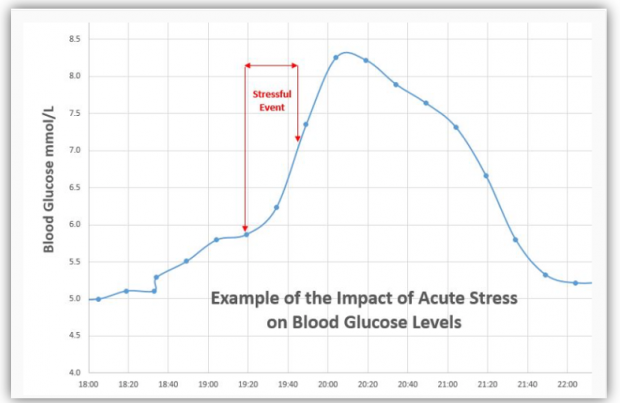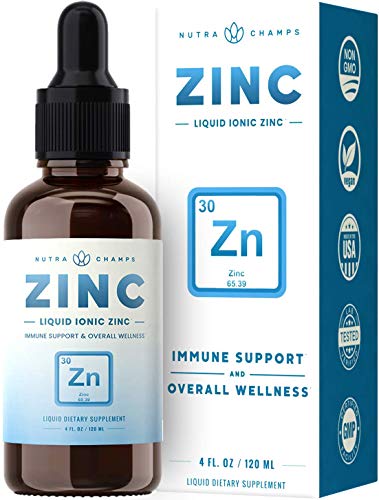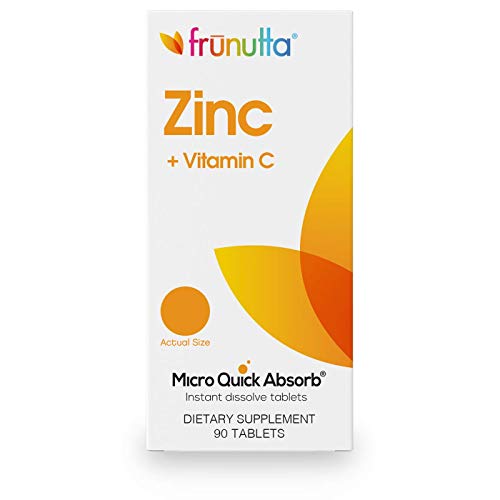Why Cancer Can't Be Cured
By Bill Sardi
March 29, 2021
Acute stress is unique to man. The chart below reveals the amount of adrenal stress hormones (cortisol) released by humans compared to other animals.

There are exceptions: guinea pigs, fruit bats, primate monkeys. These four species share a genetic flaw. Unlike other mammals, these do not synthesize ascorbate from their liver (ascorbate being the medical term for vitamin C).
A liver enzyme (gulonolactone oxidase) required to produce vitamin C is missing in humans due to a defect in the GULO gene. Animals that internally synthesize vitamin C handle stress naturally. Humans are unable to handle stress adequately because of the genetic flaw that impairs internal vitamin C production.
Animals that synthesize ascorbate are known to maintain blood plasma at saturation levels regardless of health challenges, dramatically increasing vitamin C-production internally in response to physical or emotional stress.
It was biochemist Irwin Stone in the 1970s-1980s who showed that humans have a genetic flaw that resulted in the inability to internally produce vitamin C as most other animals do.
Stone then noted the present-day requirement for vitamin C (60-200 milligrams/day) is at least 300 times less than the amount of vitamin C produced endogenously each day by other mammals. For example, an unstressed goat makes ~13,000 milligrams of vitamin C internally per 150-lbs of body weight.
Why humans don’t all have scurvy
Dietary intake of vitamin C is paltry compared to the internal synthesis humans experienced before this universal gene mutation affected all of humanity (110 mgs/day versus 1000s of mgs/continuously). One would think every human being would develop symptoms of scurvy – – fatigue, anemia, weak blood capillaries, hemorrhage, skin bruising, lassitude, painful joints, bleeding gums, shortness of breath, nausea.
Humans make up for their inborn vitamin C deficiency by recycling vitamin C. As vitamin C is exposed to oxygen in the blood circulation it is converted into an oxidized form called dehydroascorbate (DHA).
Dehydroascorbate is structurally similar to glucose and can be taken up into red blood cells. DHA within red blood cells then converts back to ascorbate vitamin C. This recirculation of DHA back to ascorbate is what spares every human from dying of scurvy, which is a frank vitamin C deficiency (below 11.4 micromole blood concentration).
More about stress and vitamin C

But let’s return to the subject of stress and vitamin C. It is no wonder ascorbate levels are the highest in the adrenal glands. It is where all the stress/survival hormones come from.
It is physical or emotional stress that activates the adrenal glands, located on top of the kidneys, to secrete stress hormones (called cortisol, adrenalin, epinephrine/ norepinephrine) that in turn release sugar stores in the form of glucose from the liver into the blood circulation. Said another way, stress induces high blood sugar levels.

Blood sugar & vitamin C
Experiments have repeatedly shown that humans subjected to mental or physical stress experience a rise in blood sugar levels. Modern medicine calls this diabetes, but in fact it could more accurately be called stress disease emanating from a lack of vitamin C.
It is categorically impossible for most mammals to develop diabetes/high blood sugar because blood glucose is converted to vitamin C.
But this stress/sugar relationship creates a more serious problem than elevated blood sugar. Physical or mental stress creates a breeding ground for the most dreaded of diseases – – cancer.
The Warburg Effect
It was Otto Warburg in the 1930s who observed that tumors take up enormous amounts of glucose. This became known as the Warburg Effect.
When doctors seek to confirm whether a mass revealed in a x-ray is cancerous or not they order a CAT-scan with injected radioactive sugar. The sugar goes right to the tumor and lights up the scan.
Because
cancer cells voraciously utilize sugar for their growth, this scan
accurately displays the size and shape of the tumor mass and sequential
scans reveal growth or regression.
 Organic Zinc Sulfate L...
Buy New $18.95 ($4.74 / Fl Oz)
(as of 02:28 EDT - Details)
Organic Zinc Sulfate L...
Buy New $18.95 ($4.74 / Fl Oz)
(as of 02:28 EDT - Details)
Sugary foods increase cancer risk by 23-200%.
Cancer patients are often advised to curb their sugar consumption because cancer cells feed off of dietary sugar, sucrose (cane sugar) and fructose (corn sugar).
However, glucose is a sugar naturally produced in the liver that is an essential source of energy in all the cells of the human body. The human brain accounts for 2% of the body by weight but consumes 20% of glucose-derived energy (utilizes 5.6 milligrams of glucose per 100 grams of brain tissue per minute). The brain needs sugar to facilitate thinking capacity.
Low blood sugar may result in a person seeing spots before their eyes which is resolved with consumption of a sugar cube. So, there is no practical way to put a halt to glucose sugar so cancers won’t grow.
In one experiment cancer researchers, attempting to out-smart cancer, combined two medicines to induce a die off of cancer cells. The first drug was a beta blocker that blocks adrenalin secreted from the adrenal glands. The second drug was a sugar blocker (glycolysis inhibitor). The drug combo reduced tumor cell growth and induced tumor cell die off (apoptosis). But we still don’t have a cure for cancer.
Glucose gives tumor cells an advantage. Elevated sugar levels negate programmed cell death, a process called apoptosis (a-puhp-tow-suhs). Inhibit glucose and tumor cells are more likely to die off naturally. Glucose inhibitors (sugar blockers) are posed as the answer to this problem.
But there is still no cure for cancer because sugar in the form of glucose is still being pumped out of the liver, more so when a person hears the fear-evoking diagnosis of cancer!
If not sugar blockers, then maybe more vitamin C
So, if sugar cannot be blocked then maybe vitamin C intake can be increased to knock out cancer. Of course, modern medicine ridicules this idea. But doctors utilize sugar scans to diagnose cancer and cancer researchers experiment with sugar-blocking drugs to “cure cancer.”
Nay-sayers claim water-soluble vitamin C, with a half-life of 30 minutes, produces nothing but expensive urine. But Patrick Holford points out that consumption of 2500 milligrams of vitamin C per day more than triples blood plasma levels compared to “Recommended Daily Allowance” levels despite its rapid excretion.

Vitamin C provided to lab animals where tumor cells have been experimentally implanted experience a 4-fold delay in tumor growth compared to animals that do not secrete vitamin C internally. In one experiment, when laboratory mice that were genetically altered to nix internal vitamin C synthesis, tumor growth factors were reduced by more than two-fold. In the animal lab, even a moderate decrease in tissue ascorbate content, to levels still considered adequate for normal health, had a significant impact on tumor pathology.
When tumor cells are experimentally injected into animals that have been supplemented with vitamin C, tumor spread (metastasis) is reduced by 71% and growth factors by 98%, and tumor weight by 28%.
Nickel is a heavy metal. Exposure to nickel is associated with toxicity and cancer. Laboratory animals that have had their GULO gene incapacitated are 40% more likely to be susceptible to nickel-related cancer.
Vitamin C renaissance
Vitamin C therapy for cancer is undergoing a renaissance. The failure of modern medicine to discover a cure for cancer has caused researchers to revisit the vitamin C paradigm of cancer.
Cancer patients exhibit very low amounts of ascorbate (vitamin C).
 Curing the Incurable: ...
Best Price: $22.60
Buy New $18.89
(as of 08:55 EST - Details)
Curing the Incurable: ...
Best Price: $22.60
Buy New $18.89
(as of 08:55 EST - Details)
The cancer cell-killing activity of vitamin C is attributed to transient production of hydrogen peroxide. According to a report published in Frontiers of Pharmacology, the administration of oral vitamin C achieves blood plasma concentration can reach 100-200 micromole whereas intravenous vitamin C achieves concentration as high as 15 millimole. (1 millimole = 1000 micromole)
Some reports claim only high concentration of vitamin C achieved by intravenous vitamin C administration have been demonstrated to kill cancer cells in a lab dish (and not kill off healthy cells).
When high blood plasma concentrations of vitamin C are maintained at 1 millimole or above, hydrogen peroxide (H2O2) is generated which selectively kills cancer cells and does not harm healthy cells.
A millimole (MIH-lih-mole) is the amount of a substance equal to a thousandth of a mole –a measure of the amount of a substance within a soluble base. Also called mmol.)
Mega-dose (20,000 to 50,000 milligrams) vitamin C administered orally or (100 grams) intravenously has been used to transiently induce hydrogen peroxide (H2O2) which selectively kills cancer cells and not healthy cells. H2O2 converts to H2O (water) which is totally harmless and non-toxic.
But the problem here is that intravenous infusions cannot easily be administered 24-hours a day for cancer patients without continual hospitalization. In between infusions of vitamin C the cancer cells roar back to life. (Chemotherapy has the same problem.)
However, in a lab dish anti-cancer effects have also been demonstrated with more modest concentrations of vitamin C (below 1 micromole and even 1 micromole).
Humans must obtain vitamin C totally from their diet, about 110 milligrams per day in America. Compare that to wild gorillas that consume 8000mg of vitamin C a day largely by eating bamboo.

Measures of blood levels of vitamin C in the US population reveal 13% of the population is vitamin C deficient (below 11.4 micromole/liter blood sample). The mean was 51.4 micromole with smokers exhibiting having a one-third lower level (38.6 micromole) than nonsmokers (2009 data).
The turnover (intake, transport, utilization, excretion) of vitamin C as a water-soluble nutrient is rapid and constant. It must be continually replaced. Most oral vitamin C is excreted within 30 minutes. The depletion of vitamin C is accelerated during illness, in particular in cases of cancer. There are anecdotal reports of cancer remissions among patients taking oral vitamin C, but these are not commonly seen.
In
contrast, animals that synthesize ascorbate are known to maintain plasma
saturation levels regardless of health challenges. In animals that
have had their GULO gene experimentally disabled, it was possible for these animals to achieve the same blood concentrations of vitamin C as animals with a functional GULO gene via
high-dose supplementation. Supplemental vitamin C given to laboratory
mice with a non-functional GULO gene activated natural killer (NK) cells
that eradicate cancer cells.
 Lypou2013Spheric Vitam...
Buy New $119.85
(as of 03:33 EDT - Details)
Lypou2013Spheric Vitam...
Buy New $119.85
(as of 03:33 EDT - Details)
Researchers in Canada provided vitamin C in drinking water to laboratory mice without a functional GULO gene, enough to raise their blood plasma levels of vitamin C equivalent to mice that produced vitamin C internally and report this roughly tripled their lifespan.
If the average lifespan in developed nations is about 75 years today, if the GULO gene flaw could be repaired, people would live 225 years on average! Don’t tell that to the population control advocates.
Blood plasma levels of vitamin C do not reflect the concentration of vitamin C in healthy organs. Tissue levels of vitamin C are higher than blood plasma levels, up to 20-micromole. The adrenals, brain, lymph nodes, lung and liver exhibit highest concentrations.
Oxygen-starved tumor cells (hypoxia)
As tumors rapidly grow, malignant cells in the center of the tumor mass are deprived of oxygen and this ignites the production of a protein called hypoxia-inducing factor (HIF-1) and other growth factors (vascular endothelial growth factor or VEGF) that induce outcropping of new blood vessels to facilitate delivery of oxygen.
The formation of these new abnormal blood vessels is called angiogenesis or neovascularization. In this manner, tumor cells are connected to sources of energy that feed the tumor.
Low HIF-1 activity results in reduced angiogenesis and slower tumor growth rates whereas increased HIF-1 activity promotes resistance of cancer cells to treatment by chemotherapy and radiotherapy and is associated with poor prognosis in many cancer types.
HIF-1 is the master regulator of responses to low oxygen (hypoxia) in cancer as it regulates tumor growth and spread. High-grade, fast-growing tumors accumulate less vitamin C than low-grade tumors. Provision of vitamin C to tumor cells in a lab dish suppresses HIF-1 and reduces cancer aggression.
When the vitamin-C producing enzyme gulonolactone oxidase is added to liver cells in a lab dish, ascorbate is produced and HIF-1 is reduced.
Among animals that do not internally produce vitamin C a strong relationship between C and activation of tumor growth by HIF-1 has been noted. The daily provision of high-dose vitamin C in lab animals that have been genetically altered not to secrete vitamin C internally depresses HIF-1 levels.
Modern medicine attempts to treat cancer with drugs that inhibit HIF-1. But none can replace continuous vitamin C synthesis in the liver.
Contact inhibition
What initially triggers the rapid growth of cancer cells? The general answer for solid tumors is that there is a wound of some kind induced by trauma, infection, hemorrhage, etc., that triggers repair mechanisms which become perpetual. Cancer has been called a wound that will not heal.
Vitamin C is an extracellular antioxidant, that is, it helps maintain the gooey connective tissue that surround and supports cells. When connective tissue is disturbed, wound healing growth factors are generated. It is believed cancer begins in connective tissue. The integrity of connective tissue must be maintained to prevent the spread (metastasis) of cancer much like mortar keeps bricks in place.
 Premium Liposomal Vita...
Buy New $28.95 ($4.82 / Fl Oz)
(as of 02:41 EDT - Details)
There is a biological phenomenon known as contact inhibition which is defined as cessation of cellular movement, growth and division upon contact with surrounding cells.
When living cells are placed into the center of a lab dish they will
replicate and spread into a layer one-cell-thick mass and cease growth
once they have spread to the edge of the dish, as all cells are in
contact with one another.
Premium Liposomal Vita...
Buy New $28.95 ($4.82 / Fl Oz)
(as of 02:41 EDT - Details)
There is a biological phenomenon known as contact inhibition which is defined as cessation of cellular movement, growth and division upon contact with surrounding cells.
When living cells are placed into the center of a lab dish they will
replicate and spread into a layer one-cell-thick mass and cease growth
once they have spread to the edge of the dish, as all cells are in
contact with one another.
HIF-1 inhibits proteins responsible for cell-to-cell contact. The importance of maintaining healthy vitamin C levels cannot be overemphasized to preserve the microenvironment surrounding cells in order to prevent cancer.
In 2009 investigator Steve Hickey and colleagues demonstrated that oral dose vitamin C fabricated for maximum absorption can achieve 400+ micromole blood plasma levels above the previously believed maximum (220 micromole per liter blood sample) and above the blood concentration of 280 micromole/liter shown to produce cancer-killing hydrogen peroxide, which has been shown to selectively kill cancer cells.
Hickey and colleagues showed that the longer exposure of cancer cells to vitamin C anti-cancer therapy (from 1 to 24 hours) greatly increases the anti-cancer activity. Hickey’s “dynamic flow” model of vitamin C advises taking oral vitamin C at 4-5 equal intervals throughout the day.
Dr. Abram Hoffer’s oral vitamin C supplementation regimen produced an unprecedented 5.7-8.0-year survival with a regimen that consisted of 12,000 mg of vitamin C daily combined with zinc and niacin.

Absorption of oral vitamin c
You are on board…. You are convinced vitamin C supplements are needed to make up for the gene mutation that has plagued all of humanity. But taking oral vitamin C is not equivalent to making vitamin C internally as humans once did. The primary reason is lack of oral absorption. Oh, the gastric tract will be bathed in vitamin C for sure. But with advancing age humans secrete less stomach acid (hydrochloric acid) which is required to absorb vitamin C. The absolute absence of stomach acid (achlorhydria) is reported to occur in 19% of adults in the fifth decade of life and 69% in the eighth decade of life. About 35% of Americans have H. pylori infection that shuts off stomach acid secretion and therefore limits vitamin C absorption.
Furthermore, less vitamin C is absorbed as dose increases. Here is a chart that will help understand the problem.

Restoration of the GULO gene
 Frunutta Zinc 5 mg + V...
Buy New $14.99 ($0.17 / Count)
(as of 05:10 EDT - Details)
Now if only the gene to produce the enzyme (gulonolactone
oxidase) that converts blood sugar (glucose) to vitamin C were restored
to functionality, presumably it would be very difficult for humans to
develop cancer till later in life. Animals in the laboratory that
naturally secrete vitamin C live ~80+% of their lives completely free of
adverse health symptoms.
Frunutta Zinc 5 mg + V...
Buy New $14.99 ($0.17 / Count)
(as of 05:10 EDT - Details)
Now if only the gene to produce the enzyme (gulonolactone
oxidase) that converts blood sugar (glucose) to vitamin C were restored
to functionality, presumably it would be very difficult for humans to
develop cancer till later in life. Animals in the laboratory that
naturally secrete vitamin C live ~80+% of their lives completely free of
adverse health symptoms.
The ability of animals to secrete vitamin C wanes with advancing age, likely due to iron overload.
Attempts have been made to restore a functional GULO gene in lab animals. In one experiment a virus was employed to treat genetically-flawed GULO-negative animals, thus showing that gene therapy is plausible. That experiment was published in 2008. Over a dozen years later, most of humanity remains genetically flawed.
Will cancer ever be cured? Not without restoration of the body’s ability to convert glucose sugar produced in the liver to ascorbate (vitamin C).


Do as the animals do
The genetic flaw that halts endogenous vitamin C secretion from the liver is a single gene disorder. As such, theoretically it can be corrected.
There is a code called a START CODON in the GULO gene to start making the GULO enzyme, and a STOP CODON to halt its production once the enzyme is completely formed. Unfortunately, there is a premature STOP CODON that completely blocks secretion of this enzyme.
A biological phenomenon known as STOP CODON READTHROUGH is accomplished by finding the proper molecule, in this instance, a molecule extracted from olives.

When this molecule was consumed in a human trial, it doubled the blood plasma levels of vitamin C without additional dietary or supplemental vitamin C. A number of synergist molecules were assembled that are required by animals and humans to produce vitamin C internally and then formulated into a dietary supplement. Both urine and blood tests reveal this formula does more than double vitamin C blood levels even among smokers and after consumption of alcohol, which is known to abolish vitamin C blood levels. The formula has been shown to raise vitamin C blood levels without fail so far.

Addendum
Attempting to cure cancer using conventional methods (slash, burn, poison) or any other methodologies is futile without addressing the genetic flaw that allows glucose sugar to continually feed any existing tumors. Cancer treatment today is like calling the fire department and dousing the flames with water at one end of the inferno while pouring gasoline on the other end.
A
disease-care system that is focused on any diagnosis with an insurance
billing code attached to it becomes a selfish industry solely governed
by profits over cures. Prevention is not profitable. Treatment without
a cure is the unstated paradigm.
 EZ Melts C for Immune ...
Buy New $17.99 ($0.30 / Count)
(as of 09:06 EDT - Details)
EZ Melts C for Immune ...
Buy New $17.99 ($0.30 / Count)
(as of 09:06 EDT - Details)
Unless cancer’s sweet tooth is removed, cancer will continue to be a major cause of death. The conversion of glucose sugar to ascorbate is the answer to the conundrum that is cancer.
Our understanding of genetics now allows us to understand how to correct this single gene disorder, by understanding how to employ molecular medicine to manipulate stop and start gene codes to restore internal synthesis of an enzyme that converts glucose sugar to vitamin C.
Confused patients and misdirected family members who insist upon the most accomplished Mayo Clinic-trained oncologist, and somehow believe a miracle will happen, for a diagnosis that remains without a cure, are fooled time and again. Patients and loved ones can’t imagine such callous indifference, such intentional misdirection. It’s slow murder by a different name.
Cure cancer and you bring down a multi-billion industry, crash the healthcare sector of the stock market, bring down Big Pharma, eliminate hundreds of thousands of jobs, and abolish the need for $6.56 billion in appropriations for the National Cancer Institute. Cease paying for cancer treatment and cures will materialize overnight. “The root of all evil is the love of money.” The cure posited within this report, patients will have to discover on their own.
The anecdotal report of a postman with a prostate tumor who tried the remedy mentioned in this report, comes to mind. With a gloved hand he could rectally feel the size of his tumor. After about eight weeks taking the nutraceutical that has been shown to elevate vitamin C levels without dietary or supplemental sources of vitamin C, he reports his tumor shrunk and vanished.
That is how penicillin was proven in 1941,
based on the evidence of one. After successful treatment of the first
patient, a 43-year-old policeman who had a sight-threatening eye
infection, penicillin was called a miracle drug. No double-blind
placebo studies were needed. It just worked.

No comments:
Post a Comment